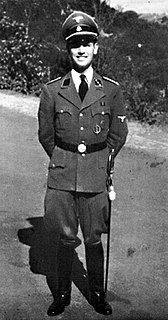
Erich Priebke was a German mid-level SS commander in the SS police force (SiPo) of Nazi Germany. In 1996, he was convicted of war crimes in Italy, for commanding the unit which was responsible for the Ardeatine massacre in Rome on 24 March 1944 in which 335 Italian civilians were killed in retaliation for a partisan attack that killed 33 men of the German SS Police Regiment Bozen. Priebke was one of the men held responsible for this mass execution. After the defeat of Nazi Germany, he fled to Argentina where he lived for almost 50 years.

The Ardeatine massacre, or Fosse Ardeatine massacre, was a mass killing of 335 civilians and political prisoners carried out in Rome on 24 March 1944 by German occupation troops during the Second World War as a reprisal for the Via Rasella attack in central Rome against the SS Police Regiment Bozen the previous day.
Karl Hass was an SS Hauptsturmführer and German spy who helped deport more than 1,000 Italian Jews to Auschwitz. A perpetrator in the Ardeatine massacre, in which 335 civilians were murdered, he was tried and convicted in Italy in 1998. He spent the last years of his life under limited house arrest in "the splendor of the beautiful Swiss Alps".
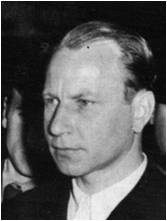
Herbert Kappler was a key German SS functionary and war criminal during the Nazi era. He served as head of German police and security services in Rome during the Second World War and was responsible for the Ardeatine massacre.

Paolo Emilio Taviani was an Italian political leader, economist, and historian of the career of Christopher Columbus. He was a partisan leader in Liguria, a Gold Medal of the Resistance, then a member of the Consulta and the Constituent Council, later of the Italian Parliament from 1948 until his death. Several times minister in the Republic’s governments. He was author of studies on economics and important works on Christopher Columbus, University professor and journalist.
Giorgio Bàrberi Squarotti was an Italian academic, literary critic and poet. He taught at the University of Turin from 1967 until his death in 2017. He was considered to be one of the most important literary critics of his time.

Massacre in Rome is a 1973 Italian war drama film directed by George Pan Cosmatos about the Ardeatine massacre which occurred at the Ardeatine caves in Rome, 24 March 1944, committed by the Germans as a reprisal for a partisan attack against the SS Police Regiment Bozen. The film was based on the 1967 book Death in Rome by Robert Katz. An Italian court gave producer Carlo Ponti and director Cosmatos a six-month suspended sentence for their film which claimed Pope Pius XII knew of and did nothing about the execution of Italian hostages by the Germans. The charges eventually were dropped on appeal. The names of the victims are shown in the closing credits, as opposed to the cast credits and crew members.
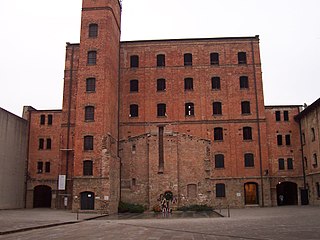
Risiera di San Sabba is a five-storey brick-built compound located in Trieste, northern Italy, that functioned during World War II as a Nazi concentration camp for the detention and killing of political prisoners, and a transit camp for Jews, most of whom were then deported to Auschwitz. SS members Odilo Globočnik and Karl Frenzel, and Ivan Marchenko are all said to have participated in the killings at this camp. The cremation facilities, the only ones built inside a concentration camp in Italy, were installed by Erwin Lambert, and were destroyed before the camp was liberated. Today, the former concentration camp operates as a civic museum.

Manzoni–Museo della Liberazione is an underground station on Line A of the Rome Metro, inaugurated in 1980. It is located under the junction of Viale Alessandro Manzoni, Via Emanuele Filiberto and Via San Quintino, in Esquilino rione.
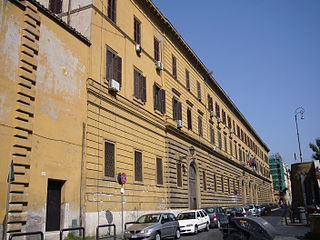
Regina Coeli is the best known prison in the city of Rome. Previously a Catholic convent, it was built in 1654 in the rione of Trastevere. It started to serve as a prison in 1881.

Polizeiregiment "Südtirol", later Bozen, and finally SS-Polizeiregiment "Bozen", was a military unit of the German Ordnungspolizei recruited in the largely ethnic-German Alto Adige region in north-east Italy in late 1943, during the de facto German annexation of the region. The ranks were ethnically German Italian draftees while officers and NCOs were Germans.

The Piazza Tasso massacre was a massacre that occurred on July 17, 1944, at Piazza Tasso in Florence, Tuscany, Italy.

Roberto Lordi was Brigadier General of the Regia Aeronautica, Gold Medal of Military Valour Recipient and Martyr in the Fosse Ardeatine Massacre.

San Vittore is a prison in the city center of Milan, Italy. Its construction started in 1872 and opened on 7 July 1879. The prison has place for 600 inmates, but it had 1036 prisoners in 2017.
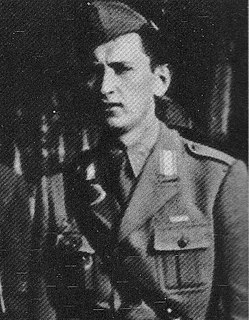
Maurizio Giglio was an Italian soldier and policeman. In September 1943, during World War II, the Italian government concluded an armistice with the Allies. He thereafter transmitted military intelligence by radio from Rome about the Nazi forces there to the Allied forces advancing through southern Italy. In March 1944, he was captured, and was executed by the Nazis. He was posthumously awarded the Gold Medal of Military Valour, a decoration which acknowledges deeds of outstanding gallantry. Places have been named, and memorials dedicated, in his honour.

The Via Rasella attack was an action taken by the Italian resistance movement against the Nazi German occupation forces in Rome, Italy on 23 March 1944.
Raffaele Aversa was an Italian soldier and Resistance member, most notable for having carried out the arrest of Benito Mussolini after his dismissal as Prime Minister of Italy on 25 July 1943.

Giuseppe Cordero Lanza di Montezemolo was an Italian soldier and Resistance member.
Giovanni Frignani was an Italian soldier and Resistance member, most notable for his role in the arrest of Benito Mussolini after his dismissal as Prime Minister of Italy on 25 July 1943, in the arrest and death of Ettore Muti, and in the Roman Resistance after the Armistice of Cassibile.
Sabato Martelli Castaldi was an Italian Air Force general and a member of the Italian Resistance during World War II.

















